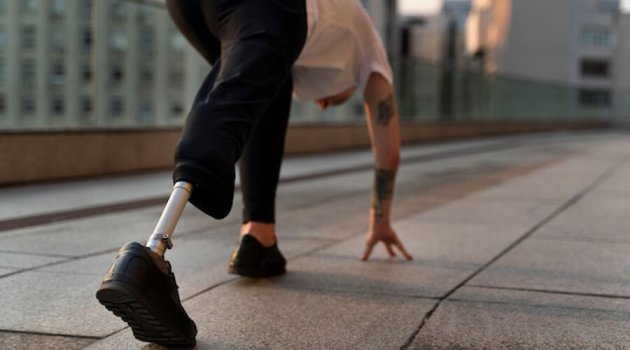The 21st century has made many impossible things possible. It has taken us to a day where the physically impaired walk and the deaf hears and responds. It is not a miracle, but technology is making extraordinary changes. According to the World Health Organization (WHO), about 15% of the world’s population (over one billion people) have some kind of disability. It is not a good idea to have people guide and help them throughout their life. Fortunately, technology has come to their rescue. Artificial intelligence (AI) is the development of computer systems that are able to perform tasks that normally require human intelligence. With the help of AI and its applications, people with disabilities can live normal life like everybody. Unlike others, people with disabilities see artificial intelligence as a light at the end of the tunnel. In the developing era of technology, the gap between people with disabilities and the world keeps narrowing.
Artificial intelligence directly impacts disabled people’s lives in three ways- enabling communication, enhancing accessibility, and providing the advantage to live independently. People with no disabilities might take Alexa, Echo, and Siri as a device that plays songs, book tickets, tell weather conditions, etc for us. But for people with disabilities, these voice-assisted AI technologies are one of the major advanced ways of communication. Visually impaired people use voice assistants to communicate with the world. Similarly, speech-to-text transcriptions and text-to-speech conversions are also availed for impaired people to address their physical issues. Accessibility is a major concern for people with disability. A person in a wheelchair or a visually impaired individual can’t travel to certain places without the help of others. However, an advanced navigation system tracks locations and says where a wheelchair can be easily accessible. Meanwhile, visually impaired people use recognition technology to identify what is around them, especially, signboards, traffic signal color, zebra crossing, etc. The smart home is a futuristic technology that is seeing high adoption among people in recent days. Fortunately, the AI-assisted devices in a smart home enable people with disability to live independently.
While a lot of AI applications are deployed at various places to make people with disabilities live normal life, some of the technologies have direct positive impacts on them. AI solutions leverage more than just comfort. It makes an absolute environment where impaired people can show equal potential to others. AI-powered applications are able to equate visually or physically impaired workers with the rest of the employees by giving them an opportunity to even operate in the workplace. A sophisticated device called Orcam My Eye 2 is capable of reading books, recognizing faces, and even recognizing the value of money and some other common items. This advanced device uses technologies such as AI, OCR (optical character recognition), and machine learning. Extended Reality (XR) is an emerging umbrella term for all immersive technologies like augmented reality (AR), Virtual Reality (VR), and mixed reality (MR). By availing of XR, people with motion disabilities can carry out assignments and work tasks remotely. Robots also play a big role in helping people with disabilities. Starting from robotic arms and prosthetic legs to assistant vehicles and automatic devices mounted on wheelchairs, robotics is remarkably making its stance. ReWalk company, a well-known health technology provider makes robotic products and services that help in rehabilitation.
Continue reading: https://www.analyticsinsight.net/artificial-intelligences-impact-on-the-lives-of-people-with-disabilities/
Artificial intelligence directly impacts disabled people’s lives in three ways- enabling communication, enhancing accessibility, and providing the advantage to live independently. People with no disabilities might take Alexa, Echo, and Siri as a device that plays songs, book tickets, tell weather conditions, etc for us. But for people with disabilities, these voice-assisted AI technologies are one of the major advanced ways of communication. Visually impaired people use voice assistants to communicate with the world. Similarly, speech-to-text transcriptions and text-to-speech conversions are also availed for impaired people to address their physical issues. Accessibility is a major concern for people with disability. A person in a wheelchair or a visually impaired individual can’t travel to certain places without the help of others. However, an advanced navigation system tracks locations and says where a wheelchair can be easily accessible. Meanwhile, visually impaired people use recognition technology to identify what is around them, especially, signboards, traffic signal color, zebra crossing, etc. The smart home is a futuristic technology that is seeing high adoption among people in recent days. Fortunately, the AI-assisted devices in a smart home enable people with disability to live independently.
While a lot of AI applications are deployed at various places to make people with disabilities live normal life, some of the technologies have direct positive impacts on them. AI solutions leverage more than just comfort. It makes an absolute environment where impaired people can show equal potential to others. AI-powered applications are able to equate visually or physically impaired workers with the rest of the employees by giving them an opportunity to even operate in the workplace. A sophisticated device called Orcam My Eye 2 is capable of reading books, recognizing faces, and even recognizing the value of money and some other common items. This advanced device uses technologies such as AI, OCR (optical character recognition), and machine learning. Extended Reality (XR) is an emerging umbrella term for all immersive technologies like augmented reality (AR), Virtual Reality (VR), and mixed reality (MR). By availing of XR, people with motion disabilities can carry out assignments and work tasks remotely. Robots also play a big role in helping people with disabilities. Starting from robotic arms and prosthetic legs to assistant vehicles and automatic devices mounted on wheelchairs, robotics is remarkably making its stance. ReWalk company, a well-known health technology provider makes robotic products and services that help in rehabilitation.
Continue reading: https://www.analyticsinsight.net/artificial-intelligences-impact-on-the-lives-of-people-with-disabilities/

